espace
Meeting copyright obligations when depositing to espace
The Open Scholarship Policy was implemented in 2024, adding Curtin University to the growing movement of international universities supporting the retention of authors’ rights. The policy supports the dissemination and preservation of scholarly outputs by making them openly accessible in espace.
The policy simplifies Curtin researchers’ copyright obligations by institutional rights retention–researchers pre-emptively grant Curtin the license to make their research open access in an institutional repository. It is still important to identify which version of the research publication can be deposited in espace.
Research outputs in their published form will display a copyright statement similar to:
© Publisher/Commissioning Body 2022. All rights reserved.
© Publisher/Commissioning Body 2022. Open Access CC BY.
© The Authors 2022. All rights reserved.
© The Authors 2022. This is an open access publication under CC BY licence.
If publications do not have a copyright statement, you must assume the content is © Publisher 2022. All rights reserved.
Research outputs with the copyright statement ‘© Publisher 2022. All rights reserved’ do not permit the published version to be made openly available in espace without the express written permission of the publisher.
However, Curtin’s Open Scholarship Policy grants to the University the right to make Author Accepted Manuscripts by Curtin authors available in an espace.
Copyright statements such as ‘© The Authors 2022. This is an open access publication under CC BY licence’ specifies the authors retain copyright and permit sharing of the published version under an open licence.
Copyright statements such as ‘© Publisher 2022 Open Access CC BY’ specifies the publisher retains copyright but permits sharing of the published version under an open licence.
The published version is permitted to be deposited in espace in both these circumstances.
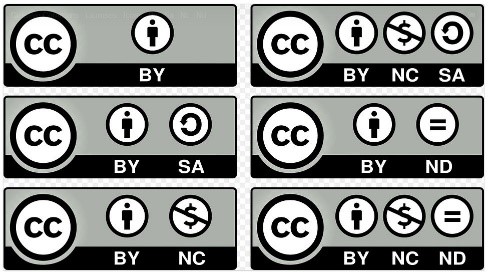
Look for Creative Commons icons on research publications to determine if the published version is suitable to be deposited to espace under an open licence.
‘All rights reserved’ is a declaration by the copyright holder to indicate that they reserve all of the rights granted to them by the copyright law. This includes
- reproduction (copying, scanning),
- adaptation (editing a work, creating a new work based on this work),
- performance (displaying a work publicly),
- publication, and
- communication (posting or sharing a work online).
If no copyright statement is included in the material, it should be assumed that ‘all rights reserved’ applies.
Making research publications open access via espace
Researchers can make their research open access by depositing a copy of their publication into espace. This is known as Green Open Access, where the author publishes their research and then deposits, or ‘self-archives’, a version of the research in a freely accessible institutional repository.
Refer to the individual publication types below for more information on author self-archiving rights and selecting the correct version to deposit to espace.
Researchers can make their research open access by depositing a copy of their journal article into espace. The journal version suitable for public access in espace is often dependent on the journal publishing model selected by the author(s). Generally this is a choice between:
-
Open accessing publishing - published articles made freely available to everyone, subject to specific licence conditions. Payment is generally through author or funder payment of an Article Processing Charge.
-
Traditional subscription publishing - published articles made available to institutions and individuals through subscription fees or pay per view arrangements.
Open access publishing
Researchers can upload the published version or enter the DOI or URL when completing the espace Deposit Process via Elements.
Generally the published version can only be displayed in espace if the author has retained copyright or published their research under a Creative Commons licence.
Published journal articles will look similar to the following example:
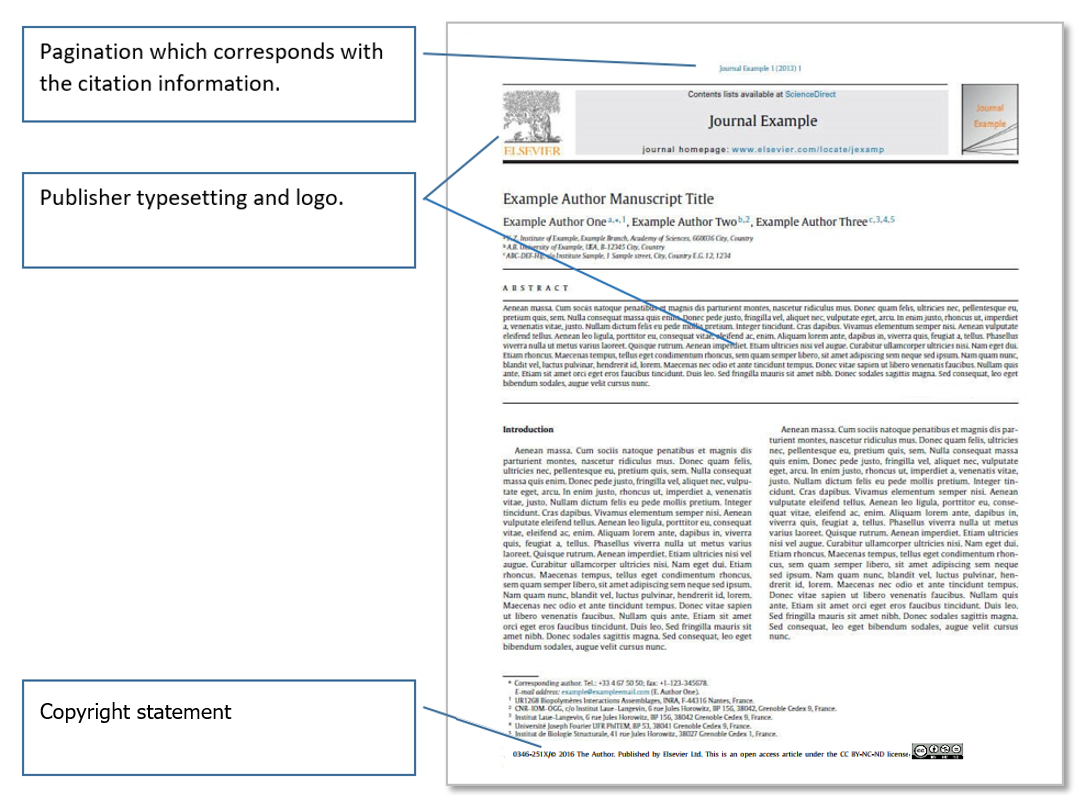
Traditional subscription publishing
The Open Scholarship Policy allows Curtin researchers to deposit their accepted manuscript in Curtin’s institutional repository and does not require authors to negotiate this right with publishers.
This means researchers can follow traditional publishing route with any publisher or journal of their choice, even with journals not covered by the Read and Publish Agreement, and make their research open access through the repository.
Researchers need to obtain the accepted version of their publication for deposit to espace.
The accepted version, also known as the author’s accepted manuscript, is the final version that has undergone peer review and been accepted for publication but has not yet been copy-edited and formatted for publication. The accepted version may be a Word document or a PDF.
Accepted versions (accepted manuscripts) will look similar to the following example:

Prior to making full text of a published work available, the espace team checks to ensure the deposited version complies with publisher policies such as embargo periods, and copyright provisions.
Note: different provisions apply to reuse of journal articles in Higher Degree Research (HDR) theses. For more information refer to Copyright for HDR students.
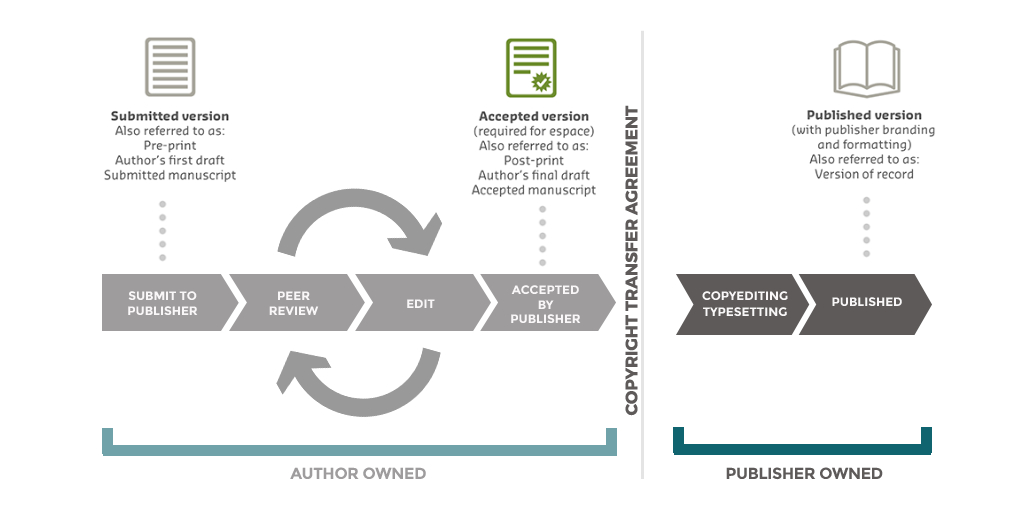
Image attribution: Dr Melodie Garnier from https://unlockingresearch-blog.lib.cam.ac.uk/?p=1872
Submitted version
- The version of the article before peer review or editing, as submitted by an author to the journal.
- The submitted version is also know as Author’s Original Manuscript (AOM), Pre-print, Author’s first draft.
- As the submitted version has not yet undergone peer review, this version of the article is not suitable for deposit to espace.
Accepted version
- The version of the article that has undergone peer review, incorporated referee comments, final author revisions and been accepted for publication, but has not yet been copy-edited and formatted for publication.
- The accepted version is also known as the Author’s Accepted Manuscript (AAM), Post-print, Author’s final draft.
- For journal articles published under the traditional subscription model, it is the accepted version that most publishers permit researcher to deposit to espace.
Published version
- The version of the article that has been peer reviewed, edited, formatted and typeset. It includes citation details, tagging and indexing by the publisher.
- The published version is also known as the Version of Record (VOR) or the Final published version.
- Generally, the published version can only be displayed in espace if the author has retained copyright or published their research under a Creative Commons licence.
For further information on Journal article version terms refer to the 3-minute Video: Understanding journal article versions
Researchers should deposit the version closest to the published version which can legally be made available.
If a researcher has published under the open access model or the publisher agreement allows the final published version to be made available in an institutional repository, deposit the published version.
For researchers publishing under the traditional subscription model, deposit the author’s accepted version.
Researchers are encouraged to save a copy of the final accepted version of their journal article once it has been accepted for publication. With the shift to article submissions via journal online portals, publishers increasingly expect the corresponding author to retain their own copy of the accepted version suitable for self-archiving in an institutional repository.
It may also be possible to obtain a copy of the accepted version of a publication via the journal’s online submission portal.
Step 1: Identify the journal’s online submission portal
From the journal’s website, locate the “Submit Your Paper” or similar option. This will generally direct you to log into the journal’s online submission portal. Note the type of online submission portal. For example:
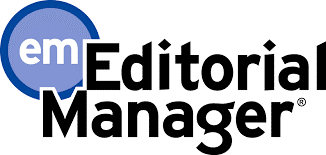

Step 2: Identify the corresponding author
The corresponding author is traditionally responsible for overseeing the online publishing process with the journal and has access to the online submission portal.
Step 3: Obtain a copy of the accepted version from the journal’s online submission portal
If you are the corresponding author simply follow the instructions for the appropriate submission portal below to locate and download a copy of the accepted version.
If you are not the corresponding author, please contact and request they download a copy of the accepted version, using the appropriate submission portal instructions.
Instructions to obtain the accepted manuscript version are available for the following online submission systems:
-
Editorial Manager
Instructions for the corresponding author to obtain a copy of the accepted manuscript via the Editorial Manager online submission portal. -
ScholarOne Manuscripts
Instructions for the corresponding author to obtain a copy of the accepted manuscript via the ScholarOne Manuscript online submission portal.
If your journal accepts manuscript submissions via email or uses a bespoke submission portal, please contact your journal’s editor to request a copy of the accepted manuscript suitable for author self-archiving in espace.
Step 4: Upload the accepted manuscript to espace via Elements
For detailed instructions on depositing to espace via Elements refer to Curtin’s Elements Publications Manual, located under Elements Training in the Curtin Staff Portal.
Book or book chapters
The right for an author to self-archive a copy of a book or book chapter is made possible by the Open Scholarship Policy. Deposit these in the repository via Elements.
Published versions of chapters or whole books are seldom permitted to be made openly available in espace unless published Open Access.
Conference papers
The right for an author to self-archive a copy of a book or book chapter is made possible by the Open Scholarship Policy. Deposit these in the repository via Elements.
Published versions of conference papers are seldom permitted to be made openly available in espace unless the author retains copyright or the proceedings are made available under an open licence.
Conference outputs suitable for deposit to espace
Conference papers reporting on original research and published in their entirety are suitable for deposit to espace.
Presentation slides and posters are not in scope for deposit to espace at this time.
Reports published via government, institutional or commercial organisations may not have clearly established or articulated guidelines around copyright and re-use of content.
The Report Clearance Checklist for Deposit to espace prompts researchers to consider a range of issues such as confidentially, privacy and copyright to assist in making reports openly available through espace.
The checklist also prompts researchers to consider applying a Creative Commons licence to the report or request the minting of a DOI (digital object identifier) through Curtin Library.
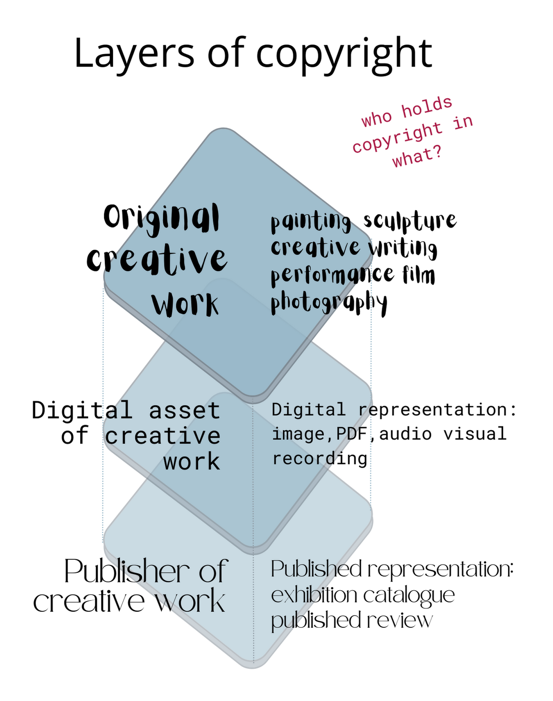 Navigating copyright associated with creative works can be especially complex. For example a Curtin Researcher may need to deposit a digital representation of a creative work to espace, rather than the creative work itself. This may add a layer of copyright obligations specific to the digital asset, as well as any copyright considerations associated with the original creative work.
Navigating copyright associated with creative works can be especially complex. For example a Curtin Researcher may need to deposit a digital representation of a creative work to espace, rather than the creative work itself. This may add a layer of copyright obligations specific to the digital asset, as well as any copyright considerations associated with the original creative work.
The Creative Works Clearance Checklist for Deposit to espace is designed to prompt Curtin Researchers to consider a range of issues such as confidentially, privacy and copyright and assist in making creative works openly available through espace.